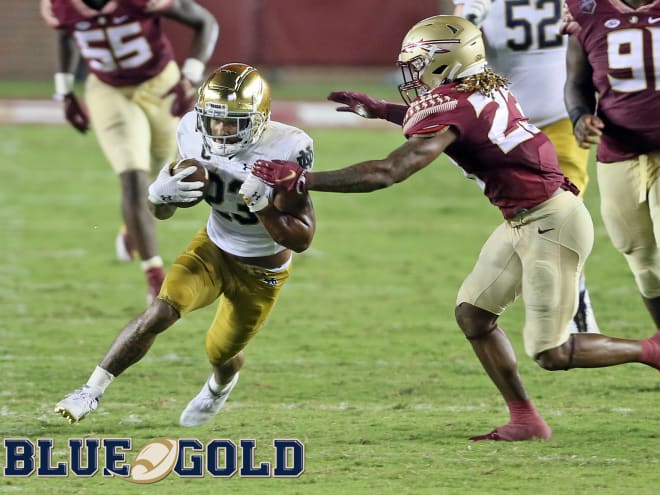Notre Dame seeking run-game fixes after opening-day dud: ‘We’ll get better’
Notre Dame averaged 2.76 yards on 26 designed run plays and won a game.
Those woeful rushing numbers would have made winning a game a non-starter in many of Brian Kelly’s first 11 seasons as head coach. Not in 2021, it appears.
Notre Dame still scoring 41 points and defeating Florida State in its 2021 opener Sunday is a testament to the strengths it has elsewhere — an aggressive quarterback, an elite tight end and a go-to No. 1 receiver. The trio of Jack Coan, Michael Mayer and Kevin Austin Jr. delivered many of the big plays that kept the Irish offense buoyant despite its absent run threat.
In all, Notre Dame called passes on 44 of its 70 plays from scrimmage. That’s a 62.8 pass play rate and a 180-degree pivot from its 2020 hammer-in-search-of-nail rushing identity. The Irish threw the ball on all but one of their five short-yardage third and fourth downs. Two of those were touchdown passes.
One game is too early to declare confidently Notre Dame is shifting to a pass-centric, aggressive and downfield-geared offense this year. One outing with those rushing problems and that passing prowess, though, invites such a possibility. It’s safe to say Notre Dame won’t be going full Air Raid. Its backfield returned a 1,125-yard rusher in Kyren Williams and a sub-4.4 runner in Chris Tyree.
They will be involved, which their 25 combined carries against Florida State confirm.
Neither was the problem Sunday. They were hit at or behind the line of scrimmage on 72 percent of their carries. (Williams’ 2020 hit-at-line rate was 39.8 percent, for comparison). All but 12 of their 73 combined rushing yards against Florida State came after first contact.
Yes, one-game samples can be statistical anomalies, but this is clear: If Notre Dame is going to pose a threat on the ground this year, its offensive line has to provide more help. The Irish can’t settle for moderate impact from two dynamic players, even if the team comes to learn they’re best served leaning on a potentially dynamic passing offense.
“We’ve got to run the ball better,” Kelly said after the game. “Clearly that will be an emphasis. We’re not here to throw the ball all over the yard and not have a solid run game.”
The next day, after watching tape, Kelly didn’t sound concerned about his squad's ability to reach that point. Notre Dame wasn’t going to field another Joe Moore Award finalist offensive line in one year. Not with four new starters. Not when a freshman and a Conference USA grad transfer are two of them. Nor was that new group likely to be at its peak cohesiveness and ceiling on opening night.
The Irish didn’t generate much push in the run game and couldn’t control the line of scrimmage, but it wasn’t obviously overmatched. Kelly pinned most of the problems on communication and unity off the snap — things that should improve with more time together.

That gelling process took a hit, though, with freshman left tackle Blake Fisher’s knee injury that will likely sideline him for a few weeks. Fisher, a five-star recruit in the 2021 class, won the job with an impressive spring and fall camp. He’s as talented as any lineman on the roster. Sophomore Michael Carmody, a former top-250 recruit himself, replaced him and had a bumpy debut.
“I’m not here to make any excuses for anything relative to the run game,” Kelly said. “We have to run the ball better, there’s no doubt. But when you’re in silent cadence, when you’re utilizing tight ends on the perimeter, it makes for a difficult cadence to get everybody moving at the same time. We struggled a little bit with that, in unison getting off the ball.”
That turned into a lack of consistent edge-setting and a drop in double-team effectiveness, Kelly said. The byproducts are less room to run to the outside, which Williams and Tyree rudely discovered, and a lack of holes between the tackles.
“These are things that are easily worked out,” Kelly said. “When you evaluate your running game, you worry about being overwhelmed at the point of attack. That’s a good [Florida State] front and they have some good players, but these are things we have to make some adjustments with.”
There’s enough talent on the line to suggest it’s capable of satisfactory run blocking. It returned a 21-game starter and projected future draft pick at center in Jarrett Patterson. It is starting a senior (Patterson), a fifth-year senior (right tackle Josh Lugg) and a sixth-year senior (right guard Cain Madden).
Like its predecessors, this is a unit mainly comprised of four-star recruits. Even in years of mass turnover, its usually strong collection of talent helps produce above-average line play, at worst.
A dominant run-game outing against Mid-American Conference opponent Toledo won’t erase all concerns, but it won’t be meaningless either. It’s the first place to start for a line that must make some in-season improvement, even if it’s likely to fall short of great this year.
“We did not see any red flags that are going to say, ‘This is going to be difficult this year,’” Kelly said. “We’ll get better running the football.”

----
• Learn more about our print and digital publication, Blue & Gold Illustrated.
• Watch our videos and subscribe to our YouTube channel.
• Sign up for Blue & Gold's news alerts and daily newsletter.
• Subscribe to our podcast on Apple Podcasts.
• Follow us on Twitter: @BGINews, @Rivals_Singer, @PatrickEngel_, @tbhorka and @ToddBurlage.
• Like us on Facebook.


